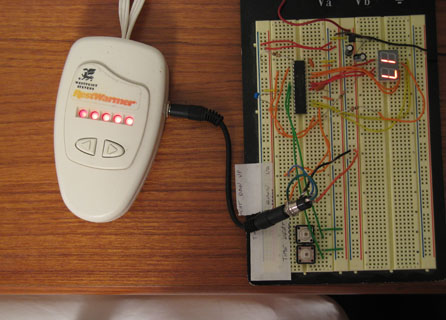
[Bob] and his wife use a bed heating pad. In the winter, they typically turn it on about an hour before bedtime so the bed is nice and warm. The problem is, if they accidentally leave it on, they’ll wake up a few hours later: overheated. What they needed was an advanced timer system.
A normal outlet timer wouldn’t fit his needs: most of the year the pad should shut off after a slight delay, but in the winter they prefer to leave the heating pad on at a much lower temperature. [Bob] decided to create a custom timer with a microcontroller to provide adjustable duration and heating levels.
The circuit is simple. It consists of a microcontroller, a 2-digit LED display, two buttons, and two wires that connect to the heating pad’s original controller. The final build allows you to set the time the pad turns on, turns off, and/or down a few levels. It’s a fantastic hack, and you can see how the interface works in the video following the break.















I like the idea of being able to set the timer in advance, but most modern heating pads/blankets have an auto-off timer built in.
Hi James. We didn’t want auto-off; we wanted auto-reduce, e.g. leave the heating pad on all night, but at a lower level.
Hmm.. 2 thoughts, wouldn’t it likely have been easier to replace the current limiting resistor in the transformerless supply to increase the amount of available power instead of so much optimization? Also…RTC.
Hi TehMeh. I actually did replace the controller’s current-limiting resistor. As I wrote on my web page “I replaced the heating pad’s current-limiting resistor too, making its LEDs a little dimmer but saving 2mA.” But it still wasn’t enough.
I use a small heating pad in the winter, but the idea of sleeping on an entire bed of carbon fiber wire @ 120v doesn’t seem healthy. Are there any studies on the dangers of the EMF’s created from electric blankets?
When this article came down through the tips line, I actually had the same question. This site may help: results appear somewhat inconclusive.
I’d be worried about soaking it in sweat.
If we all weren’t so geeky our women would cuddle us to warm us up :(
In addition to this heating pad timer, I’ve also made a sous vide cooker for her. C’mon, this stuff is FAR more useful than, say, diamond jewelry!
Just make sure code with failsafe (or enable watchdog timer…)
I have a heating pad on my bed and it has an auto shutoff feature that activates after 10 hours (so much for sleeping “all” day. I wrongfully assumed they all come with those there days to prevent the unfortunate case of burning ones house to the ground.
And sorry Bob, But I do not get the love affair with sous vide cookers that every hipster/hacker blog says we all most own now. It gives food (meat) the nasty gray cadaver look of non-browning styles of cooking gives food, like poaching, which if thats what your going for, works just as well and I’ll skip all that crap anyway and just cook it like a normal human. I think too many geeks have watched too much iron chef and think overly technical ways of preparing food makes them cool, like tattoos, beards, skinny jeans and scarves… None of them do IRONICALLY.
KleenexCommando, you’re absolutely right about the sous vide. I made it, we tried it out on a couple of steaks, and stopped using it for that. Now, we use it for controlling the temperature when making homemade yogurt or french fries. One of these days, I want to try it out on fudge, since that requires careful temperature control.
Does it have a “his” and “her” side feature? (c:
wretch, I made two of them: one for her controller and one for mine.
Awesome!
Without a schematic, it’s hard to say for certain, but this project likely exposes the user of the outside controller to hazardous AC line voltages. Almost certainly so without a polarized plug.
NateOcean, the heating pad controller converts 120V AC to 4.7V DC. My timer taps into that 4.7V. There’s no 120V in my timer. The only way my timer can be dangerous is if the heating pad controller becomes dangerous.
Hello everyone.
This is for a heating blanket, not a heating pad.
I am looking to build a simple controller for a heating pad.
The problem is mine has 3 wires.
Has anybody opened the stitching on one of these to figure out what the 3rd
wire does?
Tks